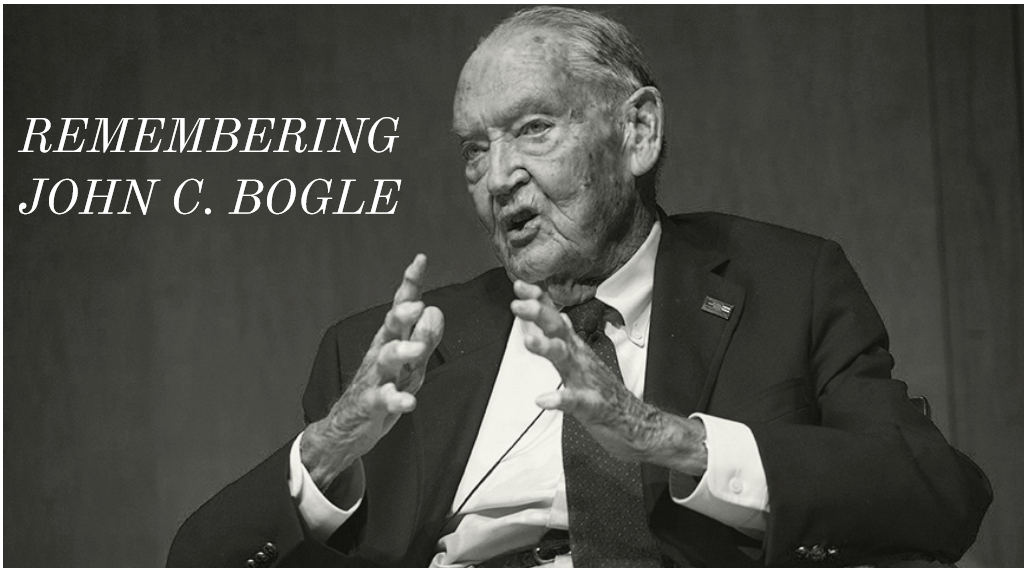John Bogle’s Life Achievements
As we have seen, index funds and index ETFs can be very potent investment vehicles for the average investor. John Bogle, in his The Little Book of Common Sense Investing, explains the advantages of this particular mode of investing as follows:
“Simply by buying a portfolio that owns the shares of every business in the United States and then holding it forever. It is a simple concept that guarantees you will win the investment game played by most other investors who—as a group—are guaranteed to lose.”[i]
For John Bogle, it’s a simple decision: Buy index funds. Keep buying index funds. Then, sit back and profit! With that little statement, he changed the investment management industry forever.
In the following article, we will remember John Bogle, who he was, the challenges he overcame and his final mission.
Who was John Bogle?
Academics in the 1960s started analyzing mutual fund returns and their high-flying performance funds more closely, and began to wonder what, exactly, an active fund manager contributed to the performance of a fund. What they found surprised them. The data suggested that, after adjusting for risk (and luck couldn’t be separated from skill), few active managers actually beat the markets. As a group, mutual fund managers had no special talents. The heavyweights in academics started to theorize that most investors would be better off just buying the market itself if they could. This started the infamous “passive” versus “active” debate that continues to this day.
Academics demanded a passive form of investing into stock markets, but to no surprise, the money management industry wasn’t impressed. They accused passive management proponents’ findings as too theoretical, and incompetent in managing other people’s money. Besides, one trump card always worked in this heated debate:
They would refer to the fact that there weren’t any financial products that only mirror entire markets!
And they were right; there weren’t any index fund products in the offering – until 1971.
There had been sporadic attempts by a few crack-pot financial nerds at small financial institutions to mirror benchmark indices, but they all failed in the execution and never gained the momentum for a breakthrough. What they missed was a strong personality with leadership skills; someone who was willing to ruffle some feathers and to challenge the Boston establishment. They needed someone like John Clifton Bogle!
A Princeton graduate – hardworking, ambitious, and ruthless – he would overcome all hurdles his few predecessors couldn’t take.
In August 1976, the first publicly available index mutual fund was launched under the name “First Index Investment Trust” (later changed to Vanguard 500 Index Fund). That year, Bogle was the chairman of yet an unknown company, registered with the SEC under the name of The Vanguard Group of Investment Companies.
John Bogle and the History of Vanguard

You might ask yourself: why such an abrupt change of position? At Wellington, he had always been a great operational manager and fervent promoter of Wellington Company, helping it survive the challenging period of post-war and the go-go years. He was what Edward Johnson, II, and Gerald Tsai represented at Fidelity – the necessary generation change.
However, where Johnson would grow the Fidelity brand and finally pass on the reign to his son, who would later pass it on to his daughter, Bogle wasn’t destined for the same smooth path. In some respect, it was his own fault.
In the excellent biography by Lewis Braham, The House That Bogle Built, you can read up on a fascinating success story that, to a very large extent, reads more like a corporate thriller than a story about a man on a holy mission.
Vanguard originated out of a corporate power struggle at the top of Wellington Management that Bogle lost. It left him only the two options: to either leave Wellington completely or take over the administrative function of Wellington Funds far away from the center of power in Boston. He opted for the latter, but with some aces up his sleeve.
Wellington’s board didn’t think much of Bogle’s choice to become an administrator of the assets they controlled. He wouldn’t have real executive power in making investment decisions, managing any money, or even raising funds. Wellington thought of Bogle’s new position as a sort of consolation prize to soothe his personal pride.
However, they underestimated Bogle’s resolve.
In May 1975, he would simply launch a new administrative entity, under the name Vanguard Group (The Vanguard Group of Investment Companies). This company would be responsible for, well, controlling the investment management company, that was required by law. Remember, 1929, and the Glass Steagall Act of 1933? The investing part and the administrative part needed to be separated and that was what Bogle did!
Bogle followed the law to the letter, and he took his administrative responsibilities for Wellington Investment Management very seriously. But it soon became apparent that he didn’t see himself as simple administrator.
Johng Bogle Index Funds
Rather, he aimed to influence Wellington Management through the new power he gained at the administrative level – Vanguard Group. Strangely enough, the fund’s board, which was distinctly different from the board of the investment advisor (Wellington), had more power than Bogle’s opponents had anticipated.
This left Bogle with plenty of room to make life at Wellington more than complicated. However, one problem remained for Bogle and his newly formed entity. How could Bogle take over the money management function as well without violating his agreement with Wellington? How could he get more and more control of all the fund’s investment management functions while slowly detaching himself from Wellington? It dawned on him that creating the first index fund was the perfect solution to circumvent (and not violate) his agreement to not manage any money – as technically no active advisory mandate was necessary for creating an index fund. After all, all he had to do was to copy a market index.
The plans for launching took shape in 1975, with Wellington strongly opposing it – but they had no say in it, as Vanguard technically wouldn’t violate any of its agreement and Bogle controlled the fund’s board.
Vanguard’s First Index fund
Finally, the Vanguard Group would launch the first publicly available index fund in August 1976. While being continuously sabotaged by Wellington in its sales and promotion efforts, it had difficulty warming up potential investors.
The initial offering attracted only $11 million, far below the $150 million Bogle had targeted. Besides being in the second ice age, the general public just wasn’t ready for this type of product yet. They still believed in the credo of beating the market indices as the ultimate goal of any self-respecting money manager.
To top it all off, his colleagues from the traditional mutual fund management companies, including Wellington, ridiculed his foray into passive investing, calling it “unpatriotic,” “Bogle’s Folly,” or accusing the rationale behind it of aiming to be “average” – a very un-American ideology, indeed. By the end of 1976, the Vanguard fund had grown to only $14 million.
Vanguard’s Success Story

And all through these years, Vanguard was able to reduce its fees. By 2000, Vanguard was by far the lowest-cost provider, having slashed its expense ratio to 0.27% for its flagship funds, while the average fund charged 1.21%. Today, it charges only 3 to 4 basis points for some of its flagship funds to institutional clients.
Vanguard’s cost advantage was a direct result of its mission to become the low-cost provider by passing on any savings to clients. It achieved this through operational efficiency and the fact of just mirroring an index without engaging in elaborate research or forecasting.
In addition to not having to pay for armies of expensive fund managers, research analysts and outside research resources, it has always had much lower marketing and advertising expenditures. With its growing asset size, Vanguard profited from an “economies of scale” effect, which allowed it to negotiate fees paid to external third-parties, such as brokers and banks.
Over the years, through constant investment in technology, Vanguard was able to further improve operational efficiency. Technology enabled Vanguard to automate the entire investment and trading process, along with the administrative processes. With this obvious cost advantage came the “word of mouth” effect, as more and more people realized they were being charged high fees for subpar or even lousy returns. This, in turn, enabled Vanguard to raise more assets and lower cost even more.
As Bogle always envisioned his work would become the people’s road to participating in a new world of owners’ capitalism and shareholder democracy – fair capitalism for all. Clients are assured that they are saving and participating in the fruits of capitalism. Index fund providers are also happy, as their asset size continuously rises, and as we know, their growth powers the entire Wall Street food chain.
John Bogle’s New Challenge – ETFs
It took some time until the industry caught up and understood the real threat that index funds posed to their existing business model. The large majority of professional money managers simply did not recognize the disruptive potential that the concept of indexing contained.
Vanguard is, and remains, “the Walmart of money management,” and in their hands the index fund as we know it was born – affordable, accessible, flexible, and dominating the industry. Anyone with a bit of money saved up can buy shares in mutual funds. The Vanguard Total Stock Market fund, for example, charges $50 for a single share, with an initial minimum investment of $10,000.
Finally, the industry caught up and new challengers would emerge. In their mission to cut cost and to pursue economies of scale, companies like State Street came up with new products that were a derivation of the traditional mutual fund index fund concept – the exchange-traded fund, aka ETF.
The first ETF was launched in 1993 by State Street. With the launch of the first ETF that was targeted foremost at retail investors, it openly challenged Vanguard for its retail index business.
By March 2000, State Street had reduced the SPDR S&P 500’s expense ratio to 0.12 percent, which was less than the Vanguard 500’s 0.18% for individual investors at that time. By then, the ETF had already attracted $17.3 billion in assets.[i]
Bogle’s End at Vanguard
New competitors would enter the field of passive investing, willing to invest in technology and using ETFs to expand their market share over Vanguard. At present, some 65 million (!) shares of Spiders ($8.8 billion worth) are traded every day. The turnover of Spider shares runs at a 3,600% annual rate. The turnover for the famous tech ETF NASDAQ Qubes is even higher, at 6,000% per year.
Besides State Street, BlackRock would enter the market with force, and in the process becoming the largest asset manager in the world.
John Bogle wasn’t impressed. He called them “the greatest shotgun ever made… great for killing big game in Africa, but it’s also great for suicide.”
“The problem is that because ETFs were designed to be traded, there is a temptation for investors to do precisely that, and at the worst possible times – buying hot ETFs at the top and selling beaten-down ETFs at the bottom.”
In 2015, John Bogle pointed out that the only “sure winners are the brokers and dealers of Wall Street.”[ii] As Braham noted, “It is a cruel irony that the index concept he helped champion has been exploited to create exchange-traded funds (ETFs) for speculators whose holding period can often be just a matter of minutes.”
Bogle was openly critical of ETFs, as they were, in his opinion, undermining his vision of an “ownership society” that would bring wealth to anyone in America that would listen to him and his simple investment philosophy. Instead, he felt that ETF would bring out the old demons of trading and gambling that he had fought all his career.
His open criticism would ultimately seal his end at Vanguard and the end of Bogle as the leader of the index fund and passive investing movement. In a move to reshuffle management at the very top of Vanguard, John Bogle retired as Chairman in 1999, at the very hight of the Dotcom bubble. Some would argue, a “forced retirement.”
As soon as Bogle was out of the way, Vanguard would launch their own ETFs. Today, Vanguard has 16% of its $3 trillion in assets in ETFs, and offers more than 50 ETFs.
John Bogle’s Last Battle
John C. Bogle deserves the respect he has received over his long career. He has always believed that long-term buy-and-hold investing in stock markets is the best strategy for the common man. In the final years, he relentlessly preached that one simple benchmark index fund is the best vehicle for that strategy. He convinced many in his industry, even Warren Buffett, master stock picker, lauded him as the man who “did more for the individual investor than anyone he’s ever known.”
He created a financial product based on sound and logical thinking, backed up by academic research, in order to provide an efficient investment product and circumvent the enduring flaws of professional money management. He was the original “disruptor” of the mutual fund world, and he changed its status quo.
He brought extreme imbalances to the once so profitable world of money management, and to his credit was called many names by his peers throughout his career. He did not only make friends.
However, over the decades, and with increased momentum in recent years, the concept of index investing has been exploited by their providers. Even Bogle admitted that index funds and their providers have been moving in a direction that doesn’t seem to resemble the initial spirit of his innovation.
For his criticism and warnings, he was publicly ridiculed as a doddering old fool – ironically, by the people who should be most grateful to Bogle for helping them create a trillion-dollar business in the first place.
Bogle could have sat back, relax and enjoy his retirement in peace, rather than risk being ridiculed by his former peers and competitors. In an effort to discredit him and his work, even his past compensation was subject of bizarre accusations.
In an article that appeared in the Boston Globe in 2006, Bogle shared his compensation package for his final years at Vanguard: “He was paid roughly $200,000 in salary and a $300,000 bonus in 1991, plus around $2 million under a partnership plan that gave employees a percentage of Vanguard’s profits.”
Critics saw this as evidence that “the Partnership Plan has proven more profitable to Vanguard executives than Vanguard’s funds have been to shareholders.” Yet his successors and his peers have extracted far more from the industry – indicative of how their relationships with their investors have changed.
He never really profited from the “index fund revolution” the same way his peers did. It is the current and next generation of Vanguard’s top managers and executives who will reap all the financial rewards of the secretive partnership plan. Besides, look at the compensation plans top executives at publicly traded BlackRock receive.
Bogle was never exploitative or overly demanding when it came to benefits and compensation plans, even though he was entitled to much more. In the early 1990s, he even gave back about 40% of his partnership share to Vanguard. His reasoning: He didn’t want to be greedy, something you won’t hear very often within the financial industry.
Among his avid followers and within the mutual fund industry, Bogle turned into a legend, a strange figure who refused to take his entire compensation because he felt obliged to his shareholders and his many loyal clients.
The Pilot Leaves the Ship
When Bogle resigned as Chairman in 1999, the money management industry lost its original disruptor and most fervent critic. You could have heard sighs of relief in many boardrooms, but Bogle being Bogle, he wouldn’t give up. Even beyond his official retirement, he would be a pain in the neck for many in the industry and for the former company he founded.
Throughout his retirement, he would continue to fight for his vision of fair capitalism, an “ownership society,” a fight he would lose in the end.
With his death on Wednesday 16th, January 2019, at the age of 89, the money management industry lost its last defender of principles. He will be mourned and remembered by all that have something to say in money management and at Wall Street. But from now on it will be clear waters for them, because, in the end, it was always, “Stay the course.”

REFERENCES
[i] See Senate Report, 1970, U.S.C.C.A.N., 4897, 4907, interpreted by the 2nd Circuit Court of Appeals in Gartenberg v. Merrill Lynch Asset Mgmt., Inc., 694 F. 2d 923, 929 (2d Cir. 1982), to connote the Senate’s awareness of “potentially incestuous” behavior.
[ii] Birdthistle
[iv] “BlackRock’s Larry Fink paid nearly $26 million in 2015.” http://www.reuters.com/article/us-blackrock-compensation-ceo-idUSKCN0WK2OA. (Accessed February 28, 2017.)
[v] Johnson, II, Edward. “How the owners of Fidelity get richer at everyday investors’ expense. http://www.reuters.com/investigates/special-report/usa-fidelity-family/. (Accessed February 28, 2017)
[vi] CNN Money Special Report “Big bank execs: What they take home.” http://money.cnn.com/news/specials/storysupplement/ceopay/. (Accessed February 28, 2017)
[vii] Braham.
[i] Ellis, Charles D.. The Index Revolution: Why Investors Should Join It Now. (Hoboken: Wiley, 2016)
[i] James Simmons from Renaissance Technologies LLC, and Edward O. Thorp, founder of Newport Partners and Edward O. Thorp & Associates, are prime examples of academics entering the business of active money management.
[ii] According to Vanguard, as of June 30, 2016, they manage more than $3.5 trillion in global assets,






